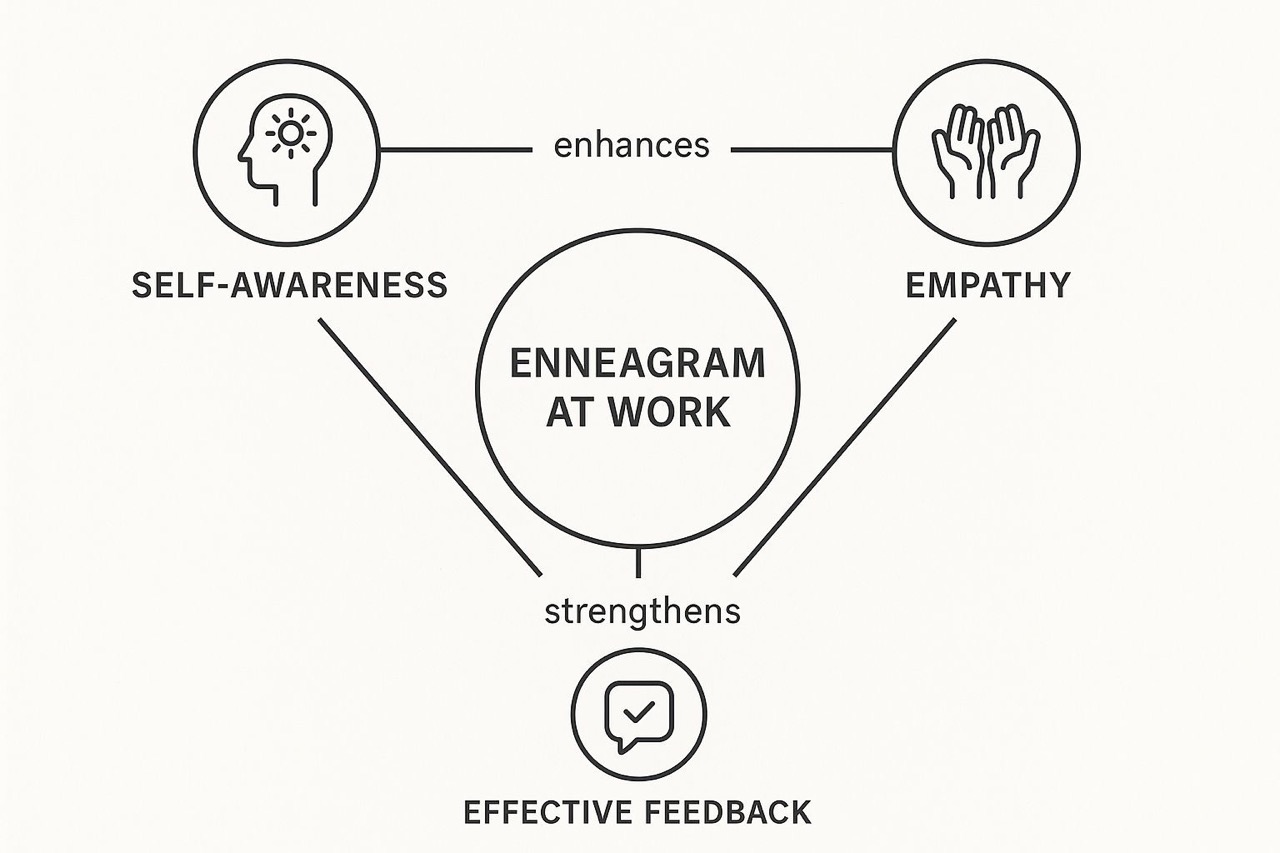Enneagram at Work: Unlock Your Team's Hidden Potential

Why Smart Leaders Are Choosing The Enneagram
Imagine a workplace where understanding each other isn't just about what people do, but why they do it. Think of it like an orchestra: instead of clashing instruments, you have a beautiful symphony of strengths, each playing its part. That's the potential of the Enneagram in action.
Unlike personality tests that simply label people, the Enneagram digs deeper. It explores the motivations driving our behaviors, offering a richer understanding of what makes individuals tick.
This deeper understanding is invaluable for leaders. Let's say a team is struggling with communication. A typical approach might be generic team-building activities. But with the Enneagram, a leader might discover the root of the problem lies in differing personality types. Perhaps a Type Five, who values quiet reflection, struggles to connect with a Type Seven, who thrives on energetic brainstorming.
By understanding these core motivations, the leader can bridge the gap, facilitating more productive communication. This leads to less conflict, clearer understanding, and ultimately, a more effective team.
Just as smart businesses are using tools like Telegram to enhance communication, the Enneagram offers a similar boost to internal team dynamics. Why Smart Businesses Are Choosing Telegram Globally, there's a growing recognition of this power. The Enneagram is increasingly being used in workplaces worldwide. A 2022 survey conducted by The Enneagram in Organizations, involving 796 people from 49 countries and in 23 languages, demonstrates its widespread impact.
Enneagram for Business Test
Ready to level up your team culture? The Enneagram for Business Test goes beyond surface-level personality quizzes. It gives you real insights into how your team communicates, collaborates, and handles conflict—based on the deeper drives behind each Enneagram type. With just a few clicks, you’ll start seeing the hidden patterns that shape your company’s dynamics. Whether you’re leading a startup or managing a large team, this test is your shortcut to building a more connected, high-performing workplace.

The Power of Self-Awareness
The Enneagram journey begins with self-discovery. When leaders understand their own Enneagram type, they gain valuable insight into their strengths and weaknesses. This self-awareness enables them to lead more effectively and connect more authentically with their team. What Is The Enneagram?
This personal growth has a ripple effect, positively influencing the entire team and creating a healthier work environment.
From Conflict to Collaboration
The Enneagram doesn't just help manage conflict; it helps understand it. When team members grasp each other’s motivations, disagreements become opportunities for growth. Instead of personal attacks, there's constructive dialogue.
This allows teams to truly appreciate their different perspectives. Friction transforms into fuel for innovation. The Enneagram empowers leaders to build truly high-performing teams, unlocking the full potential of each individual and the collective whole.
Meeting Your Team: The Nine Types In Action
Think back to your last tricky project meeting. Remember the person who kept bringing up all the things that could go wrong? That's likely a Type Six, always scanning the horizon for potential problems. And the one bursting with ideas, practically vibrating with enthusiasm? Probably a Type Seven, a fountain of innovative solutions. The Enneagram in the workplace isn't about labeling people; it's about understanding the inner drivers that shape how we act on the job.
This understanding can be incredibly powerful. Imagine a team leader assigning a crucial project. Knowing that a Type Three thrives on achievement and recognition, they might give that person the lead, allowing them to truly shine. But recognizing that a Type Nine values harmony and collaboration, the leader might offer them a supportive role, making sure everyone feels included and valued.
Recognizing The Nine Types in Action
Let's paint some pictures of how each type contributes in a workplace setting. The meticulous Type One is your quality control expert, pushing for excellence in every detail. Think of them as the polishers, ensuring a project truly gleams. The empathetic Type Two is the glue that holds the team together, building relationships and fostering a supportive atmosphere. They're the ones who smooth out ruffled feathers and make sure everyone feels heard.
Then there's the achievement-oriented Type Three, the driving force pushing projects forward. They're often natural leaders, motivated by results and recognition. The introspective Type Four brings a unique perspective, offering creative solutions that others might miss. They're the idea generators, thinking outside the box. The insightful Type Five is the strategist, providing in-depth knowledge and thoughtful analysis. They're the planners, carefully considering every angle.
Type Sixes, with their focus on security and preparedness, are the risk managers. They anticipate potential pitfalls and develop backup plans, making sure the team is ready for anything. The adventurous Type Seven brings energy and enthusiasm, injecting a can-do spirit into any project. They're the optimists, sparking innovation and driving progress.
Understanding these contributions helps build a balanced and successful team. The powerful Type Eight takes charge, fearlessly tackling challenges and advocating for their team. They’re the decisive leaders, essential in high-pressure situations. Finally, the adaptive Type Nine is the peacemaker, promoting harmony and ensuring everyone's voice is heard. They're the mediators, bringing the team together.
To help visualize these different strengths and communication styles, let's take a look at the following table:
| Type | Core Motivation | Workplace Strengths | Communication Style | Stress Triggers |
|---|---|---|---|---|
| Enneagram One | Perfection | Detail-oriented, Quality-driven, Conscientious | Direct, Formal, Principled | Imperfection, Criticism, Lack of Control |
| Enneagram Two | Helping Others | Empathetic, Supportive, Relationship-focused | Warm, Personal, Encouraging | Being unappreciated, Rejection, Feeling unneeded |
| Enneagram Three | Success | Driven, Goal-oriented, Adaptable | Confident, Persuasive, Results-focused | Failure, Lack of recognition, Being overlooked |
| Enneagram Four | Uniqueness | Creative, Intuitive, Expressive | Individualistic, Artistic, Authentic | Feeling ordinary, Lack of authenticity, Being misunderstood |
| Enneagram Five | Knowledge | Insightful, Analytical, Strategic | Reserved, Thoughtful, Objective | Intrusion, Incompetence, Emotional demands |
| Enneagram Six | Security | Loyal, Responsible, Prepared | Questioning, Cautious, Supportive | Uncertainty, Inconsistency, Betrayal |
| Enneagram Seven | Fun & Adventure | Enthusiastic, Optimistic, Versatile | Spontaneous, Engaging, Multifaceted | Boredom, Limitation, Negativity |
| Enneagram Eight | Control | Decisive, Protective, Powerful | Direct, Assertive, Challenging | Weakness, Injustice, Being controlled |
| Enneagram Nine | Peace | Harmonious, Supportive, Diplomatic | Patient, Agreeable, Accommodating | Conflict, Disruption, Pressure |
This table provides a snapshot of each type's motivations, strengths, communication preferences, and potential stressors in a workplace environment. Remember, this is a simplified overview, and individuals within each type can vary greatly.

This infographic visually represents the interplay of self-awareness, empathy, and feedback when using the Enneagram at work. By understanding your own type, appreciating the motivations of others, and offering constructive feedback, you can contribute to a more positive and productive work environment. To explore each type in more detail, check out this resource: Exploring the Nine Enneagram Types . Recognizing these patterns in our daily interactions helps us anticipate needs and build stronger working relationships, turning potential friction into collaborative energy.
The Career Success Pattern Nobody Talks About
It might surprise you to hear that certain personality types tend to earn more. It's not about one type being inherently "better" at their jobs, but rather about how different Enneagram types naturally approach work. Think of Type Threes , often drawn to leadership positions, and Type Eights , who love a challenge and thrive in competitive settings. These types often climb the corporate ladder quickly. This doesn't diminish the other types, but simply highlights how some personalities align more easily with traditional ideas of career success. This section explores how understanding the Enneagram in the workplace can help everyone find professional fulfillment, regardless of their type.

Understanding Strengths and Challenges
Some Enneagram types, like the creative Type Fours and the peace-loving Type Nines , might not feel at home in a typical corporate environment. Type Fours, driven by authenticity and self-expression, often look for work that feels meaningful rather than chasing promotions. Type Nines, who value harmony and teamwork, may prefer a supportive environment to individual accolades.
But these preferences aren't weaknesses. Imagine a Type Four's creativity in a design firm, or a Type Nine's collaborative skills leading a project team. These traits become powerful assets when used strategically.
This brings us to a key point: success is personal. The Enneagram helps us appreciate that fulfilling careers look different for each type. Reaching the corner office might be a Type Three’s dream, while a Type Four might feel most successful creating something unique and impactful. For a Type Nine, building a collaborative and supportive team could be the ultimate achievement.
Indeed, research backs this up. A Truity survey of 81,683 adults between the ages of 26 and 45 found a link between Enneagram types and income. There was a noteworthy $35,146 annual difference between the highest earners (Type Threes) and the lowest (Type Fours). Discover more insights . This data highlights how our Enneagram type can influence our career paths and potential.
Leveraging Your Type for Success
Using the Enneagram for career success isn’t about changing who you are. It's about playing to your strengths while developing skills that help you reach your goals. This could mean finding a workplace that aligns with your values, or learning strategies to overcome challenges you might face.
For example, a Type Nine who wants to lead might work on being more assertive. A Type Four pursuing a creative career might focus on how to promote their unique skills. This individualized approach to career development is what makes the Enneagram so valuable. It helps us define success on our own terms instead of following someone else's script. By recognizing our strengths and challenges, we can build career paths that feel both rewarding and fulfilling. This is the real power of the Enneagram: not simply achieving success, but defining it for ourselves. This journey of self-discovery includes understanding ourselves, building skills strategically, and being our true selves at work. It’s about realizing that each type has unique gifts, and that true success comes from aligning our work with what truly motivates us.
Transforming Team Dynamics From Good To Exceptional
The real magic of the Enneagram in the workplace happens when a whole team understands its combined Enneagram makeup. Picture a project where the detail-oriented Type One naturally oversees quality control, the innovative Type Seven generates fresh ideas, and the steady Type Nine ensures everyone collaborates smoothly – all because they understand and appreciate each other's strengths. This section explores how to practically cultivate that type awareness, beginning with open discussions about work styles and moving towards strategic role alignment.
Building Type Awareness
Building type awareness begins by creating a space for open and honest conversations about how people work best. These conversations aren’t about putting labels on anyone, but about understanding the various approaches people take. For example, a Type Five might explain their need for uninterrupted thinking time, while a Type Two might describe their preference for close collaboration. This understanding helps team members value each other’s preferences, leading to a more supportive and productive atmosphere.
Introducing the Enneagram through workshops or team-building activities can provide a shared vocabulary for discussing individual strengths. Think of it like learning a new language – everyone gains the ability to express their needs and understand their colleagues' perspectives more effectively.
Strategic Role Alignment
Once a team has a basic understanding of the Enneagram, leaders can start to strategically align roles with individual types. This means assigning tasks that energize team members rather than drain them, making the most of each person’s unique strengths. For instance, a project that requires meticulous attention to detail might be a great fit for a Type One, while a task requiring creative brainstorming could be ideal for a Type Seven.
This thoughtful approach to assigning roles boosts both efficiency and job satisfaction. When people work in roles that align with their natural talents, they are more likely to be engaged and motivated, resulting in higher quality work and a more positive team environment.
Creating Psychological Safety
Successfully implementing the Enneagram depends heavily on fostering a sense of psychological safety within the team. This allows individuals to share their Enneagram type and work style preferences without worrying about being judged or stereotyped. This safe environment encourages genuine understanding and appreciation for different approaches. It helps teams move past superficial politeness to a real appreciation for individual strengths.
The Enneagram offers numerous benefits for improving workplace culture, including better communication, increased productivity, and greater employee engagement. Companies like FormAssembly have successfully integrated the Enneagram into their team-building activities, creating a more inclusive and interconnected work environment. This shows the real positive effects of putting the Enneagram into practice.
Practical Tools for Implementation
To help teams through this transition, practical tools can be incredibly helpful. Conversation starters, meeting frameworks, and team exercises designed specifically for Enneagram discussions help teams build understanding comfortably. These tools offer a safe way to navigate potentially sensitive conversations about personality and preferences.
For example, a team exercise might involve each member sharing their preferred method for receiving feedback, which can help everyone learn to communicate effectively with each other. By providing structured ways to discuss the Enneagram, these tools pave the way for a deeper understanding and stronger working relationships. This goes beyond simple awareness to the practical application of Enneagram insights, fostering a more cohesive and productive work environment where everyone feels understood and valued. It builds a sense of belonging and promotes a team culture where everyone feels comfortable being themselves at work.
Your Roadmap: Bringing The Enneagram To Your Workplace
Ready to explore the Enneagram with your team? Think of it as a journey of self-discovery, not a quick fix. Let's chart a course for introducing the Enneagram in a way that works for your unique workplace. We’ll cover everything from those first introductions to keeping the momentum going long-term.

Choosing the Right Approach
Think about how you'll first introduce the Enneagram. A mandatory workshop can sometimes feel a bit forced. A voluntary lunchtime session might attract those who are truly curious.
Maybe start with a quick overview of the basic concepts to pique interest. This lets people explore at their own pace. Offering resources like books, articles, or even links to online tests can encourage further exploration. For instance, you could suggest: Taking our Complete Enneagram Test .
Facilitating Meaningful Discussions
Next, consider how to structure team discussions. The Enneagram isn't about putting people in boxes. It's about building understanding. Imagine exploring a new city with a map. The Enneagram helps individuals understand their own “location” and how to navigate interactions with others.
Begin by focusing on the positive aspects of each type. What strengths do they bring to the table? What are their unique contributions? This helps avoid the trap of reducing people to simple labels.
Integrating Enneagram Insights
The real value of the Enneagram is in how we use its wisdom in everyday work. It’s about more than just knowing your own type. It’s about understanding how different types interact and communicate, then using that knowledge to enhance teamwork.
For example, if you know Type Ones value precision, others can prepare more thoroughly for collaborative projects. Understanding a Type Seven's natural enthusiasm can help focus their creative energy. These insights can be incorporated into team meetings, performance reviews, and even conflict resolution.
Addressing Common Challenges
Let’s be honest, introducing something new isn't always easy. Some might view the Enneagram as just another personality test. Instead of presenting it as a definitive label, frame it as a tool for self-awareness and understanding.
Stereotyping is another potential pitfall. Emphasize that each type has healthy and less healthy expressions. This nuance is vital for true understanding and avoids oversimplification. Remember, the Enneagram should be a conversation starter, not an endpoint.
Measuring Impact
How can you measure the Enneagram's effect? Look for improvements in communication, smoother conflict resolution, and better overall team dynamics. These tangible shifts show the practical value of the Enneagram. It offers real evidence of its positive impact on your work environment.
To help you implement the Enneagram effectively, take a look at this 90-day rollout plan:
Enneagram Implementation Timeline: 90-Day Rollout Plan A practical timeline showing key milestones, activities, and expected outcomes for implementing the Enneagram in your workplace
| Phase | Duration | Key Activities | Success Metrics | Common Challenges |
|---|---|---|---|---|
| Introduction and Awareness | 1 Month | Introductory workshops, online resources, type descriptions | Increased interest and engagement with the Enneagram | Skepticism, perceived lack of relevance |
| Team Exploration and Application | 1 Month | Team discussions, type-specific workshops, communication exercises | Improved team communication and understanding | Difficulty applying insights to daily work, potential for stereotyping |
| Integration and Practice | 1 Month | Integration into existing processes (e.g., meetings, reviews), conflict resolution training | Measurable improvements in team effectiveness, communication, and conflict resolution | Resistance to change, sustaining long-term engagement |
This timeline offers a starting point for your Enneagram journey. Remember, it's a guide, not a rigid structure. Adapt it to fit your organization's culture and specific needs.
By thinking through these practical points, you can create a roadmap that makes the Enneagram a powerful tool for your team. It’s not a one-size-fits-all solution; it’s about adapting this framework to your own organization's culture and needs. This tailored approach sets you up for real, long-term success.
Leading Through Understanding: Type-Aware Management
Effective leadership isn't about using the same approach for everyone. It's about truly understanding what makes each individual tick, and then adjusting your management style to suit them. The Enneagram offers a powerful framework for this kind of personalized leadership, giving you real insight into how different personality types thrive best at work. And, let's not forget, the way you present yourself professionally matters, especially online. A strong online presence, perhaps with a professional photo on LinkedIn , can make a real difference.

Understanding Your Own Leadership Style
Just like each Enneagram type has its own set of strengths and weaknesses, so does every leadership style. Think of a Type Eight leader, for instance. They might naturally be very direct and decisive, and that assertiveness can be great for getting results and pushing the team forward. However, that same directness might not sit well with a Type Nine , who might prefer a more collaborative and peaceful environment.
The first step to becoming a better leader? Understanding your own Enneagram type. This reveals your natural leadership tendencies, and yes, even your blind spots. That self-awareness allows you to consciously adapt your style and build an environment where each team member feels supported and appreciated.
Motivating and Managing Each Type Effectively
Once you understand your own style, you can start thinking about tailoring your approach to individual team members. Imagine the difference between motivating a Type Three and a Type Four . A Type Three, fueled by achievement and recognition, might be motivated by clear goals and the chance to move up. Give them challenging projects with tangible results, and you’ll likely tap into their inner drive.
A Type Four , on the other hand, thrives on authenticity and finding meaning in their work. For them, a creative and expressive environment where their unique perspectives are valued is key. Give them projects they connect with personally, and watch them flourish.
Providing Type-Specific Development Opportunities
Professional development isn't one-size-fits-all either. The Enneagram helps you, as a leader, identify growth opportunities that truly align with each person’s natural tendencies and challenges. A Type One , for example, might benefit from focusing on accepting imperfections and learning to be more flexible. A Type Seven , however, could really grow by learning to focus their energy and see commitments through to the end.
By recognizing these individual needs, you can offer targeted support and create a culture of growth and continuous improvement. This empowers each team member to reach their full potential.
Adapting Communication and Delegation
Communication is the bedrock of good leadership, and the Enneagram can offer valuable insights here, too. Direct feedback might energize a Type Eight, but it could cause a Type Nine to withdraw. Understanding these subtleties allows you to adjust your communication for maximum impact.
Delegation can also benefit from Enneagram wisdom. A Type Six , with their focus on security and planning, might be fantastic at tasks that require careful thought and risk assessment. A Type Two , with their empathy, could be perfect for roles involving team support and relationship building. Delegating tasks based on individual strengths creates a more efficient and harmonious work environment. It also fosters a sense of purpose and allows everyone to contribute their best work.
Creating a Thriving Team Environment
The ultimate goal of type-aware management? A workplace where everyone can truly thrive. Using the Enneagram as your guide, you can build teams that are not only productive but also supportive and fulfilling. This builds a culture of understanding and appreciation, where each person feels valued for their unique contributions. The result? A team that’s greater than the sum of its parts, achieving collective success through individual strengths. This collaborative and supportive environment can lead to higher job satisfaction, less conflict, and a more engaged and motivated workforce.
Avoiding Common Mistakes And Sustaining Success
Implementing the Enneagram at work offers powerful potential, but like any robust tool, it requires careful handling. Let's explore some common pitfalls and how to cultivate lasting positive change within your team. One frequent misstep is oversimplifying personalities. The Enneagram provides a framework, not a full psychological profile.
Think of the Enneagram like a map. It's helpful for navigating, but it doesn’t depict every rock and tree. Each individual is a complex landscape, and reducing someone to their Enneagram type overlooks their unique characteristics.
Avoiding the "Box" Trap
Another common mistake is using Enneagram types as justifications for bad behavior. Saying "I'm a Type Eight, therefore I'm assertive" isn't a free pass to be aggressive. Similarly, a Type Six's tendency towards caution shouldn't excuse paralysis by analysis.
The Enneagram illuminates our tendencies, not our shortcomings. It's a tool for understanding, not excusing. The focus should be on growth and development, not labeling and limiting potential.
Also, initial excitement about using the Enneagram can fade. To sustain positive change, build systems that support ongoing development. When leaders deeply understand their teams, they can effectively anticipate and navigate transitions. For more on this, consider researching a Leadership Succession Plan.
Regular check-ins, team discussions, and weaving Enneagram principles into performance reviews can maintain momentum. This shifts the Enneagram from a one-time workshop to an ongoing process of growth and understanding.
Handling Skepticism
Not everyone will instantly embrace the Enneagram. Some might view it as just another personality test. Address such concerns openly. Explain that the Enneagram is a tool for self-awareness and understanding motivations, not for putting people in boxes.
Sharing success stories of how the Enneagram has positively influenced teams can also build buy-in. Real-world examples can help skeptics see the Enneagram's potential value.
Maintaining Balance
The key to successfully using the Enneagram at work lies in balance. Acknowledge Enneagram types, but celebrate individual differences. Use the Enneagram as a springboard for deeper understanding, not a rigid defining characteristic.
Encourage self-reflection and open communication. This fosters a culture of empathy and respect, where diversity is valued.
Practical Strategies for Sustained Success
Here are practical strategies to help your team avoid common pitfalls and sustain positive change with the Enneagram:
• Focus on Growth: • Present the Enneagram as a tool for both personal and professional growth. Encourage individuals to recognize their strengths and areas for improvement.
• Encourage Self-Compassion: • Emphasize that every Enneagram type has its unique challenges. Promote self-acceptance and understanding.
• Regular Check-ins: • Integrate Enneagram discussions into regular team meetings to foster continued learning and engagement. This also helps identify and address any emerging challenges.
• Avoid Stereotyping: • Underscore that each type has healthy and unhealthy manifestations. Discourage generalizations and promote focusing on individual nuances.
• Celebrate Individuality: • While the Enneagram offers valuable insights, remember to value each person’s uniqueness. Avoid reducing individuals solely to their Enneagram type.
By implementing these strategies, you can create a work environment where the Enneagram cultivates authentic connection, stronger communication, and enduring positive change.
Strong teams don’t just happen—they’re built with intention. The Enneagram Universe for Business is your strategic tool for uncovering what really motivates your people. Identify leadership styles, spot communication gaps, and tailor roles based on each member’s core type and wing. It’s more than a test—it’s a framework to align purpose, increase engagement, and unlock untapped potential in every corner of your organization.